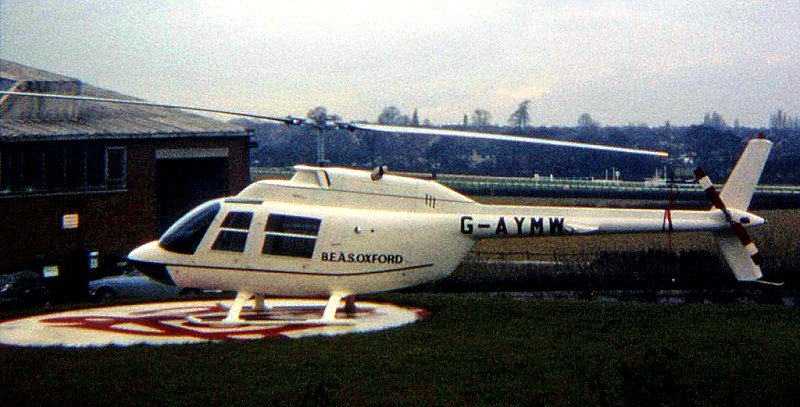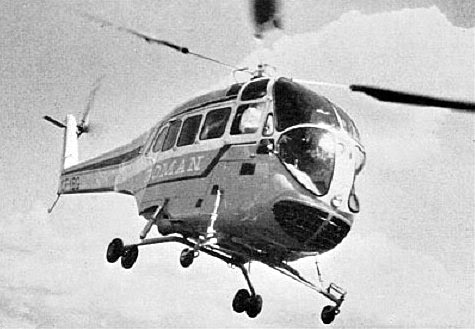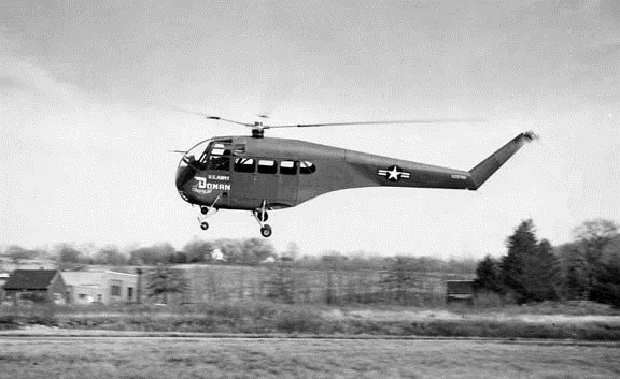G-AYMW
In post 1331 of the previous page Yoyo has contributed an image of G-AYMW which, as he rightly points out, debuted on this thread back on page 31:
 Bell 206B JetRanger G-AYMW at Leicester Racecourse on 10th January 1971 (Photo: Brian Johnstone)
Bell 206B JetRanger G-AYMW at Leicester Racecourse on 10th January 1971 (Photo: Brian Johnstone)
AYMW seems to have been imported to the UK in 1970 and sold directly to BEAS at Kidlington. From there she moves on to Wykeham Helicopters of Scarborough in 1973 and with whom she remains until 1984 when she becomes a Dollar bird.
Her registration history has her former ID as EI-BJR and the CAA file shows a period of one year (1980) where she is in Eire while under Wykeham's ownership.
Looking at the colour scheme in Yoyo's image (though it be black and white) I am guessing that our friend Denis de Ferranti had an arrangement with Wykeham and was perhaps leasing this aircraft.
Certainly if the craft was painted a gaudy gold (perhaps Yoyo can remember) then this was Denis' standard fayre when it came to colouring his rotary fleet.
 Bell 206A EI-ASW at Plymouth's Roborough Airport on 17th October 1970 (Photo: Nostalgia Thread supporter .. Chris England)
Bell 206A EI-ASW at Plymouth's Roborough Airport on 17th October 1970 (Photo: Nostalgia Thread supporter .. Chris England)
Here, EI-ASW is seen wearing the same scheme as that worn by AYMW in Yoyo's post of the previous page. I am wondering whether prior to her delivery to BEAS, AYMW flew as EI-BJR? Perhaps someone from the 'Isle' can help us!
Doman LZ5
Jeacott - thanks for the contribution of the 'grass-hopping mini-bus'. Am familiar with the Doman design and though she be ugly enough to qualify as an early Italian effort she was in fact American (although Ambrosini of Italy were looking at manufacturing this 'bug' under licence):
The Doman LZ-5 was a utility helicopter developed in the United States in the early 1950s by Doman Helicopters Inc. of Danbury, Connecticut. Despite the procurement of international manufacturing agreements, no series production of the aircraft ever occurred and only three prototypes were built. Two of these were purchased by the United States Army as the YH-31, but eventually becoming VH-31.
Like the preceding LZ-1 through LZ-4, the LZ-5 utilized designer Glidden Doman's unorthodox gimbaled rotor head system, which featured the elimination of rotor hinges and dampers and included blades of soft-in-plane dynamic design. The servo control system was entirely contained within the rotor head, with no external oil tanks or plumbing. The tail rotor was also hingeless and free floating to eliminate stresses in rapid tail rotor turns. In other ways it had a conventional helicopter main rotor and tail rotor configuration. The pilot and co-pilot were seated over the engine, which was in the nose, and a six-passenger compartment was located behind them. The engine was cooled by exhaust ejectors, producing an energy saving that increased payload by 800 pounds. The aircraft featured wheeled quadricycle undercarriage, the main units of which carried dual wheels.
Doman continued with development, building another LZ-5 aircraft in a joint venture with Fleet in Canada. The LZ-5 helicopters were simultaneously Type Certificated in U.S. and Canada in 1954. The third helicopter flew extensively in Canada under Canadian registration CF-IBG and in the United States, France, and Italy under U.S. registration N812. It flew in the Paris Air Show in 1960. This aircraft was also modified with the installation of full blind flight instrumentation, which was demonstrated extensively in the effort to sell it as a trainer. The aircraft thus equipped was advertised as the D-10. The planned production version would have been modified with a turbo-charged engine and designated as the D-10B. Doman sold production rights for military versions to Hiller and for the Italian market to Ambrosini.
 The Doman LZ4 from which the LZ5 was developed c.1949
The Doman LZ4 from which the LZ5 was developed c.1949
 The LZ5 wearing her Canadian registration CF-IBG (see above)
The LZ5 wearing her Canadian registration CF-IBG (see above)
 The LZ5 used for demonstrations with the US Army c.1954
The LZ5 used for demonstrations with the US Army c.1954
Of course Britain was not impervious to 'ugly duckling' designs and in which regard the Percival P74 which appeared on page
44 springs to mind!
.